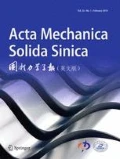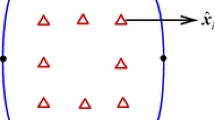Abstract
Combining Dual Reciprocity Method (DRM) with Hybrid Boundary Node Method (HBNM), the Dual Reciprocity Hybrid Boundary Node Method (DRHBNM) is developed for three-dimensional linear elasticity problems with body force. This method can be used to solve the elasticity problems with body force without domain integral, which is inevitable by HBNM. To demonstrate the versatility and the fast convergence of this method, some numerical examples of 3-D elasticity problems with body forces are examined. The computational results show that the present method is effective and can be widely applied in solving practical engineering problems.
Similar content being viewed by others
References
Lucy, L.B., A numerical approach to the testing of the fission hypothesis. Astronomic Journal, 1977, 8: 1013–24.
Nayroles, B., Touzot, G. and Villon, P., Generalizing the finite element method: diffuse approximation and diffuse element. Computational Mechanics, 1992, 10: 307–18.
Belytschko, T., Lu, Y.Y. and Gu, L., Element free Galerkin methods. International Journal for Numerical Methods in Engineering, 1994, 37: 229–56.
Zhu, T., Zhang, J. and Atluri, S.N., A local boundary integral equation (LBIE) method in computation mechanics, and a meshless discretization approach. Computational Mechanics, 1998, 21: 223–35.
Mukherjee, Y.X. and Mukherjee, S., The boundary node method for potential problems. International Journal for Numerical Methods in Engineering, 1997, 40: 797–815.
Zhang, J.M., Yao, Z.H. and Li, H., A Hybrid boundary node method. International Journal for Numerical Methods in Engineering, 2002, 53: 751–63.
Zhang, J.M., Yao, Z.H. and Masataka, T., The meshless regular hybrid boundary node method for 2-D linear elasticity. Engineering Analysis with Boundary Elements, 2003,127:259–68.
Zhang, J.M. and Yao, Z.H., The regular hybrid boundary nodes method for three-dimensional liear elasticity. Engineering Analysis with Boundary Elements, 2004, 28: 525–534.
Miao, Y., Wang, Y.H. and Yu, F., Development of hybrid boundary node method in two-dimensional elasticity. Engineering Analysis with Boundary Elements, 2005, 29: 703–712.
Miao, Y. and Wang, Y.H., Meshless analysis for three-dimensional elasticity with singular hybrid boundary node method. Applied Mathematics and Mechanics, 2006, 27(5): 673–681.
Nardini, D. and Brebbia, C.A., Transient dynamic analysis by the boundary element method, in Boundary Element Methods in Engineering, Computational Mechanics Publications, Southampton, and Springer-Verlag, Berlin and New York, 1983.
Wrobel, L.C. and Brebbia, C.A., The dual reciprocity boundary element formulation for non-linear diffusion problems. Computer Methods in Applied Mechanics and Engineering, 1987, 65(2): 147–164.
Partridge, P.W., Brebbia, C.A. and Wrobel, L.C., The Dual Reciprocity Boundary Element Method. Computational Mechanics Publications, Southampton Boston Co-published with Elsevier Applied Science, London, New York, 1992.
Brebbia, C.A. and Dominguez, J., Boundary Elements: An Introductory Course. Computational Mechanics Publications and McGraw Hill, Southampton and New York, 1989.
El-Zafrany, A., Cookson, R.A. and Iqbal, M., Boundary Element Stress Analysis with Domain Type Loading, in Advances in the Use of Boundary Element Method for Stress Analysis, Mechanical Engineering Publication, London, 1986.
Miao, Y., Wang, Y.H. and Jiang, H.Y., An improved hybrid boundary node method in two-dimensional solids. Acta Mechanica Solida Sinica, 2005, 18(4): 307–315.
Author information
Authors and Affiliations
Corresponding author
Rights and permissions
About this article
Cite this article
Yan, F., Wang, Y., Miao, Y. et al. Dual Reciprocity Hybrid Boundary Node Method for Three-Dimensional Elasticity with Body Force. Acta Mech. Solida Sin. 21, 267–277 (2008). https://doi.org/10.1007/s10338-008-0830-5
Received:
Revised:
Published:
Issue Date:
DOI: https://doi.org/10.1007/s10338-008-0830-5




